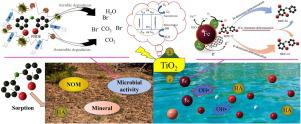Trends in Environmental Analytical Chemistry ( IF 11.2 ) Pub Date : 2021-03-26 , DOI: 10.1016/j.teac.2021.e00126 Rama Shanker Sahu , Yu-huei Peng , Chi-Fong Ko , Tzu-Ho Chou , Hepsiba Niruba Catherine , Chien-ying Yang , Chih-ping Tso , Yuh-fan Su , Yang-hsin Shih

|
Polybrominated diphenyl ethers (PBDEs), a class of brominated flame retardants, have gained the attention of many researchers due to their persistence in various environmental matrices. Their usage in numerous consumer products has lent credence to their ability to retard flammable gas formation and brought attention to their ubiquitous occurrence in the environment. PBDEs have been described as endocrine-disrupting chemicals because of their interference with the endocrine system in aquatic and terrestrial animals. In spite of the progress in research over the decades on PBDEs, a full understanding of the environmental behavior and fate of this contaminant is still elusive. Therefore, terrestrial contamination of PBDEs has been evaluated in conjunction with their levels of toxicity, transformation, and transport in various environmental compartments. This review provides a wider perspective of the behavior of PBDEs in the terrestrial environment. Through examining the numerous studies on the environmental contamination of PBDEs, a number of mounting concerns and data gaps have been identified. Numerous methodologies have been discussed including adsorption, catalytic, photocatalytic, electrocatalytic, photo-electrocatalytic, aerobic, and anaerobic degradation. The comparative PBDE degradation analysis suggests that the oxidative degradation pathway is the most appropriate way of wastewater treatment while the role of other soil ingredients on subsurface treatments is still under investigation.
中文翻译:

在陆地环境中促进多溴二苯醚降解的方法
多溴联苯醚(PBDEs)是一类溴化阻燃剂,由于其在各种环境基质中的持久性而受到了许多研究者的关注。它们在众多消费产品中的使用充分证明了它们可燃气体的阻滞能力,并引起了人们对它们在环境中无处不在的关注。多溴二苯醚因干扰水生和陆生动物的内分泌系统而被描述为破坏内分泌的化学物质。尽管数十年来对多溴二苯醚的研究取得了进展,但仍然难以完全了解这种污染物的环境行为和归宿。因此,已经评估了多溴二苯醚的陆地污染及其毒性,转化,并在各种环境隔间中运输。这项审查提供了对多溴二苯醚在陆地环境中的行为的更广阔视野。通过审查有关多溴二苯醚环境污染的大量研究,已经发现了许多令人担忧的问题和数据空白。已经讨论了许多方法,包括吸附,催化,光催化,电催化,光电催化,好氧和厌氧降解。比较的PBDE降解分析表明,氧化降解途径是废水处理的最合适方法,而其他土壤成分在地下处理中的作用仍在研究中。通过审查有关多溴二苯醚环境污染的大量研究,已经发现了许多令人担忧的问题和数据空白。已经讨论了许多方法,包括吸附,催化,光催化,电催化,光电催化,好氧和厌氧降解。比较的PBDE降解分析表明,氧化降解途径是废水处理的最合适方法,而其他土壤成分在地下处理中的作用仍在研究中。通过审查有关多溴二苯醚环境污染的大量研究,已经发现了许多令人担忧的问题和数据空白。已经讨论了许多方法,包括吸附,催化,光催化,电催化,光电催化,好氧和厌氧降解。比较的PBDE降解分析表明,氧化降解途径是废水处理的最合适方法,而其他土壤成分在地下处理中的作用仍在研究中。


























 京公网安备 11010802027423号
京公网安备 11010802027423号